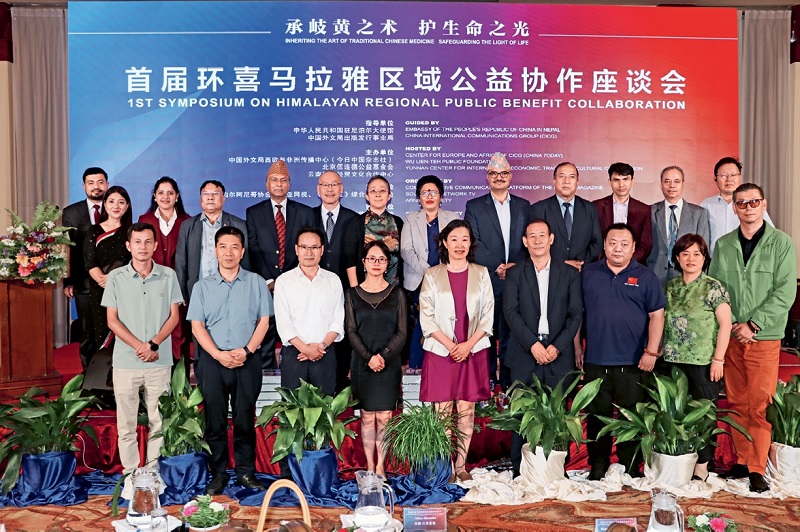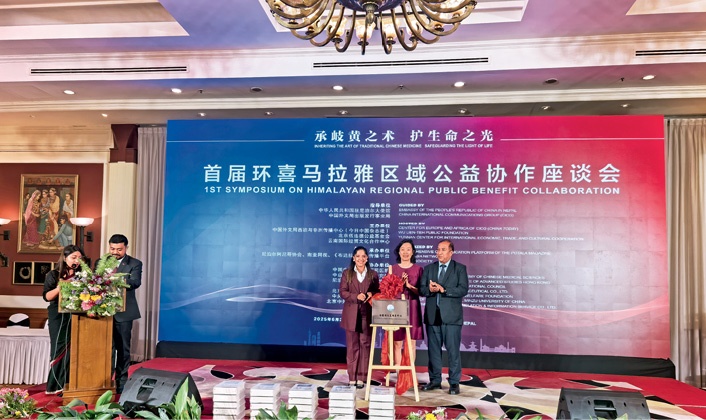China and Nepal deepen cooperation to promote traditional medicine across the Himalayan region.
The Himalayan region features a rich mosaic of cultures that are distinct yet deeply intertwined. Traditional medicine, a common treasure of human civilization, has deep roots in this region.
More than 20 experts from Nepal and China discussed ways to promote cooperation in traditional medicine at the inaugural Symposium on Himalayan Regional Public Benefit Collaboration. Themed on “Inheriting the Art of Traditional Chinese Medicine, Safeguarding the Light of Life,” the symposium was simultaneously held in Kathmandu – the main venue – as well as Beijing and Kunming on June 24.
Yu Yunquan, vice president of China International Communications Group (CICG), stated in his opening speech that in today’s globalized world, humanity is facing many common challenges, such as public health crises, natural disasters, environmental degradation, and poverty.
Held on the occasion of the 70th anniversary of the establishment of diplomatic relations between China and Nepal, this symposium was a step toward implementing the vision of building a global community of shared future at the regional level, and also an effort to enhance the provision of global public goods.

The Himalayan Regional Public Benefit Cooperation Declaration is released during the inaugural Symposium on Himalayan Regional Public Benefit Collaboration held in Kathmandu on June 24, 2025.
Cooperation in Traditional Medicine
Wang Xin, counselor at China’s embassy in Nepal, said at the event that China-Nepal healthcare cooperation has evolved into an integral pillar of the China-Nepal community with a shared future, under the visionary guidance of the two countries’ leaders. Chinese-assisted hospitals and diagnostic centers are advancing healthcare services in Nepal.
Nepal is home to abundant natural medicinal resources, while traditional Chinese medicine (TCM) carries unique diagnostic and therapeutic advantages, Wang said. By pooling strengths and sharing expertise, China and Nepal can breathe new life into traditional medicine systems, including TCM and Ayurveda, a traditional medicine system, widely practiced in Nepal, through mutual learning.
Jia Songtao, deputy secretary of the 16th Chinese Medical Assistance Team to Nepal, said the B.P. Koirala Memorial Cancer Hospital, which the Chinese medical teams have been working in, has become the largest specialized cancer hospital in Nepal.
In 2023, the Chinese medical team integrated the existing TCM and physiotherapy departments at the B.P. Koirala Memorial Cancer Hospital in Chitwan and established the International TCM Rehabilitation Center. Another Chinese medical team is based at the Civil Service Hospital of Nepal in Kathmandu, which is expected to become one of the most comprehensive public hospitals in Nepal featuring TCM.
Xu Anlong, chairman of the Beijing Wu Lien-Teh Public Foundation and one of the symposium’s co-organizers, delivered a keynote speech focused on “the shared wisdom and spirit of public benefit in traditional medicine for humanity.”
Xu, who is also the dean of the Hong Kong Institute of Advanced Studies at Sun Yat-sen University, stated that Wu was a pioneer of modern medicine in China, and his spirit of public welfare transcended borders and benefited all humanity.
Sushil Prajapati, president of the Arniko Society in Nepal, concurred that Wu’s work embodied such compassion. He said he was excited to collaborate with the Beijing Wu Lien-Teh Public Foundation for the benefit of the people of Nepal. He expressed hope that the collaboration would further strengthen the bonds between Nepal and China.
Sarbottam Shrestha, the first vice president of the Arniko Society, added that over the past decade, the association has held more than 100 medical camps, with fruitful outcomes. Among them, the free cataract surgery camp has enabled more than 500 patients to regain their sight, and the diagnosis and treatment camp that combined Tibetan and Western medicines has provided professional services to 12,000 patients.
Santosh Paudel, president of the Nepal Health Professional Federation, said that TCM methods, such as acupuncture, and traditional Chinese herbal medicine for the treatment of chronic diseases are very popular in his country. Nepal’s traditional medical practice, such as naturopathy, also emphasizes living in harmony with nature. The symposium helped both sides understand the cultural significance of traditional medicine. By sharing each other’s experiences and practices, the two sides can continue to promote the development of traditional medicine, Paudel said.
Building the Silk Road of Health
The symposium focused on four key themes: the need to strengthen public benefit collaboration in traditional medicine and healthcare; building a summit event through such collaboration; exploring strategies for developing traditional medicine industries and advancing international cooperation; and identifying specific areas for joint action, including research and development, remote consultation support, free medical services, training of TCM professionals, and health education.
Guo Lanping, director of the Institute of Chinese Materia Medica at the China Academy of Chinese Medical Sciences and director of the WHO Collaborating Centre for Traditional Medicine, attended the forum in Beijing. She noted that over the past 30 years, the Chinese government has provided extensive medical assistance to Nepal. The Nepalese government has consistently prioritized traditional medicine development, and there is a strong market demand for Chinese herbal medicine. She suggested the creation of a Himalayan traditional medicinal plant germplasm gene bank for joint conservation and sustainable use, and the promotion of ecological conservation and cultivation technologies. Governments and non-governmental organizations from both sides should expand the China-Nepal medicinal supply chain platform, enhancing market access for Nepal’s unique medicinal resources, she added.
Li Qiujuan, Party secretary at Xiyuan Hospital of the China Academy of Chinese Medical Sciences, shared the hospital’s experience in promoting TCM overseas. The hospital has conducted a series of online anti-epidemic activities and has signed memorandums of understanding with the Nepal-China Cultural and Educational Association and Lumbini Buddhist University to explore sustainable cooperation paths. She called for the establishment of a public benefit cooperation platform in the pan-Himalayan region to further strengthen the research and application of regional traditional medicine.
Jhula Ram Adhikari, president of the Chinese Medicine Doctors’ Society of Nepal, noted that in recent years, the popularity of acupuncture in Nepal has been increasing. Some renowned government and private hospitals, such as Civil Service Hospital, Annapurna Neuro Hospital, and Kathmandu Medical College Hospital, are running acupuncture services, and the integrated treatment approach is highly appreciated in Nepal.
Harish Chandra Shah, president of the Nepal-China Cultural and Educational Association, studied traditional medicine – Ayurveda – in Nepal in his early years and later spent seven years in Beijing studying TCM and acupuncture. He said that TCM is highly favored by the Nepalese people and medical professionals in Nepal. Ayurveda, traditional Chinese medicine, and the Tibetan medicine system have historically coexisted and interacted in Nepal, together forming a diversified healthcare landscape in the region.
“The significance of China-Nepal cooperation goes beyond bilateral ties; it is a key fulcrum for building the Silk Road of Health,” he concluded.

The Wu Lien-Teh Public Welfare Education Center is unveiled during the event on June 24, 2025, which will offer remote medical consultations, disseminate knowledge about TCM, and provide health education in Nepal.
For the Regional Public Benefit
Zhou Yawei, president of the China National Medical Technology Market Association, stated that traditional medicine in the pan-Himalayan region serves as a vital safeguard for public health. He said there is an urgent need to establish a system linking government, non-profit organizations, scientific research institutions, and the traditional medicine industry to highlight the value of traditional medicine in healthcare and enhance the region's resilience for sustainable development.
Zhang Jingjie, director of the Guizhou Provincial Administration of Traditional Chinese Medicine, said that Guizhou has achieved remarkable results in the cultivation and manufacturing of traditional Chinese medicinal materials, TCM scientific and technological innovation, rural revitalization, and industrial integration. Guizhou looks forward to strengthening cooperation with countries within the pan-Himalayan region to promote the vigorous development of the TCM industry.
Jiang Wei, president of Guizhou Bailing Group Pharmaceutical Co., Ltd., said that as a leading TCM enterprise in China, Guizhou Bailing has built a complete industrial chain, with annual sales revenue exceeding RMB 4 billion. The company has developed a new drug for diabetes treatment, which it has donated to patients in need. Several of its products have been registered internationally as part of its global TCM promotion strategy. He announced that Guizhou Bailing will donate a batch of commonly used medicines valued at RMB 100,000 to non-profit organizations in the pan-Himalayan region.
Tong Ze, vice chairman of the Guizhou Disabled Persons’ Federation, said that the project initiated by Guizhou Bailing in collaboration with non-profit organizations has benefited more than 50,000 diabetic patients with disabilities. He expressed hope that such public welfare cooperation between China and Nepal would help protect more people of vulnerable groups.
Zhang Jie, deputy director of the Yunnan Provincial Department of Agriculture and Rural Affairs and head of the special working group for the TCM materials industry in Yunnan, spoke at the Kunming sub-venue in Yunnan. He said Yunnan holds distinct advantages in developing Chinese medicinal materials. The provincial government has supported the development of the full TCM supply chain, making Yunnan the largest and most diverse production base of authentic medicinal materials in China.
Hu Qiang, deputy director of the Yunnan Academy of Agricultural Sciences, added that the academy has partnered with multiple organizations to establish the alliance, which focuses on collaborative innovation across the entire industry chain. It now includes more than 50 participating organizations. The alliance has signed an agreement with the Chinese Medicine Council of Hong Kong, laying the groundwork for going global of Chinese medicinal materials. He noted that Nepal, often referred to as a “treasure trove of medicinal herbs,” has a medical system highly compatible with “Yunnan medicine” gene pool. He said both sides could deepen collaboration through technological exchanges, joint establishment of medicinal herb planting bases, and talent cultivation.
Medicine Without Borders
During the symposium, the Beijing Wu Lien-Teh Public Foundation signed a tripartite agreement with the Arniko Society and South Asia Network TV. Together, they inaugurated the Wu Lien-Teh Public Welfare Education Center, which will offer remote medical consultations, disseminate knowledge about TCM, and provide health education in Nepal.
Additionally, the Potala Integrated Communication Platform of CICG signed a memorandum of understanding with SATV and the Nepal-China Media Forum to jointly launch a Himalayan regional public benefit cooperation mechanism, aimed at enhancing collaborative efforts in this field.
Experts of the cooperation mechanism briefed the forum on preparations for the first batch of charitable supplies. The Yunnan International Trade, Economic and Cultural Cooperation Center presented collector’s editions of the Compendium of Materia Medica, published by the Foreign Languages Press, to Chinese medical aid teams and institutions in Nepal. The Himalayan Regional Public Benefit Cooperation Declaration was also released.
Liu Yinghua, a distinguished researcher at the Institute of Medical History and Literature at the China Academy of Chinese Medical Sciences – and an expert in Tibetology and the international standardization of traditional medicine – stressed that education and research should be top priorities in the advancement of traditional medicine. He also emphasized the indispensable roles that local governments and international organizations play in supporting the development of traditional medicine across the pan-Himalayan region.
As one of the initiators of the public benefit collaboration mechanism, Kishor Shrestha, chairman of the Nepal-China Media Forum and Jana Aastha Media House, praised the establishment of the public benefit and dissemination office for the pan-Himalayan region.
Shrestha called on all participants – policymakers, media professionals, healers, volunteers, and visionaries – to carry this mission forward.
“Let us protect and promote the healing traditions of the Himalayas. Together, let us climb this spiritual mountain. Let us make it the tallest mountain of compassion, the widest bridge of cooperation, and the deepest well of healing that our region – and the world – has ever seen,” he said.